How Barcodes Work, Benefits & Uses
What Is a Barcode?
At a basic level, a barcode is a square or rectangle with a combination of vertical black lines of varying thickness and height, white space and numbers that together identify specific products and their relevant information. Computers linked to scanners can read these codes and use the exact combination of bars, spaces and numbers to retrieve the data for that product.
Today, barcodes are found on not only household items that come from supermarkets or retail stores, but licenses, rental cars, checked luggage and hospital bands. In each case, they identify a product or person and encode important details.
Key Takeaways
- Barcodes encode product information into bars and alphanumeric characters, making it much faster and easier to ring up items at a store or track inventory in a warehouse.
- Besides ease and speed, bar codes’ major business benefits include accuracy, inventory control and cost savings.
- There are many types of barcodes, but they all fall into two categories: linear codes, including widely used formats like UPC and EAN, and matrix codes, like QR codes.
- Barcoding has a low barrier to entry—all a business needs is a printer, scanner and basic inventory management software.
How Barcodes Work
Barcodes save time and money because they can be read by a scanner, either a handheld device or one built into a checkout station, instead of an employee having to manually key in product information.
There are two primary types of barcodes: one-dimensional (1D), like those found on food packaging or a shampoo bottle, and two-dimensional (2D), like a QR code on an advertisement that directs the user to that company’s website. Most scanners can only read 1D, or linear, barcodes, and they remain the most popular format; more on 1D vs. 2D codes later.
Two of the most common types of linear barcodes are the Universal Product Code (UPC) in the U.S. and the European Article Number (EAN) in Europe.
Barcode Components
Barcodes must be designed in a precise, uniform way so a scanner can read them and transmit the encoded data to a computer. Using various components, a barcode may also reveal the country of origin, product category and manufacturer.
The diagram below shows the different elements of a UPC barcode, followed by an explanation of each component
- Quiet zone: The empty, white space on the edges of a barcode is the “quiet zone,” and is necessary for the scanner to read the label.
- Number system digit: The first digit represents the product category on UPC codes. For example, retail products often start with 0 or 1, pharmaceuticals with 3 and coupons with 5.
- Manufacturer code: The first group of characters after that initial number usually identify the manufacturer. GS1, a global standards organization that regulates UPCs, assigns each manufacturer a unique code.
- Product code: The next set of characters identify the specific product and are created by the manufacturer.
- Check digit: The check digit confirms the accuracy of the data tied to that barcode and flags any potential errors.
Business Benefits of Barcodes
Barcodes have taken off because they offer a clear and fast return on investment. Here are the key benefits businesses can take advantage of with barcodes:
- Accuracy: Barcodes eliminate manual entry of product information at receiving, meaning there are far fewer opportunities for error. Whether in a retail store or a warehouse, associates simply swipe the barcode across the scanner. Errors in barcodes themselves are extremely rare.
- Real-time data: Each time an employee scans a barcode, it immediately updates inventory and sales numbers in the company’s enterprise resource planning (ERP) or business management system. This gives a business constant access to up-to-date data, allowing it to quickly calculate meaningful metrics ike inventory turn, value of inventory on-hand or sales per week by item.
- Reduced training: For the most part, barcodes and scanners are self-explanatory, so it doesn’t take new employees long to become efficient at the checkout counter. And, barcodes greatly reduce the need for memorization and institutional knowledge. At a grocery store, for example, the worker doesn’t have to know the codes for popular items to be productive.
- Inventory control: Barcodes improve inventory management and reduce excessive spending on products. Employees can always find the most current information when reviewing inventory positions or trends in demand, which facilitates better decisions around purchasing and discounting. This cuts down on both inventory carrying costs and obsolete inventory, which boosts long-term profitability.
- Low cost: Barcodes offer tremendous value, as the upfront investment is not large compared to systems that provide comparable benefits. Companies can create a limited number of barcodes for internal use for a low price, and as their needs grow, the cost of supporting technology remains reasonable.
History of Barcodes
Norman Joseph Woodland and Bernard Silver came up with the idea for barcodes based on the symbols in Morse code. The two recent graduates of Drexel Institute of Technology, now Drexel University, applied for a patent for the invention in 1949 and received it three years later. Woodland sought the help of his employer, IBM, in building this technology, but IBM felt technological limitations in force at that time would prevent barcodes from catching on.
The founders sold the patent to electronics company Philco in 1962, and Philco later sold it to RCA.
The railroad industry was one of the first to experiment with barcodes in the early 1960s, with a project spearheaded by David Jarrett Collins of electronics company Sylvania. To monitor the movement of railcars, Collins created a colorful barcode that was placed on the side of cars and scanned by a device next to the railroad tracks. Though this was an important first step, the system had some issues, and the Association of American Railroads gave up on it in the late ‘70s. Another early adopter was General Motors, which used barcodes to track transmissions as they moved around a factory.
Barcodes didn’t gain real traction until the mid-70s, when grocery stores started testing them. Around that same time, the National Association of Food Chains (NAFC) standardized barcodes for the industry by developing an 11-digit code. In 1977, there were still only a few hundred supermarkets using barcodes, but by 1980 thousands of stores were adding them every year. Soon, barcodes were standard in not only grocery stores but most retail environments.
Types of Barcodes
As noted earlier, there are two basic types of barcodes. Here are the basics on each and key differences:
-
Linear/1D
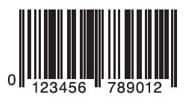
Linear, or 1D, barcodes are what most people visualize when they picture a barcode—black vertical bars with numbers below them. This is what most stores put on their products. Linear barcodes contain numbers, letters and symbols, which tie the code to a set of information in a database with details like product name, type, size and color. A 1D barcode must be linked to a database to function properly. Linear barcodes are often used on consumer goods, loyalty cards, shipping labels and books.
-
Matrix/2D
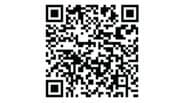
Matrix or 2D barcodes can store additional information, including quantity, images and website URLs. A 2D barcode can render this information without any connection to a database. Common uses of 2D barcodes are QR codes, which may direct users to a specific website or act as digital boarding passes. They have also become increasingly common in high-value manufacturing environments that require detailed tracking of parts and products, like medical equipment and pharmaceuticals.
Key differences
While 1D barcodes have only horizontal or vertical lines, 2D versions can have both, along with other shapes and patterns. This allows 2D barcodes to hold as many as 2,000 characters, compared with 80 characters with 1D codes. In addition, a wide variety of scanners can read linear barcodes, while 2D barcodes require more advanced scanners or smartphones. Finally, matrix barcodes can have smaller physical footprints than linear ones, so they’re often ideal for small items with minimal space for a barcode.
9 Common Product Codes
Companies developed a number of different types of barcodes as they became widely used over the last 50 years. Let’s walk through a few of the most common types of barcodes.
-
UPC
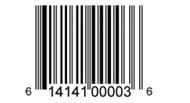
As noted earlier, this is one of the most ubiquitous barcodes. Most U.S. consumer products, from food to office supplies to home improvement goods, use UPC codes. Standard UPC barcodes have 12 digits, and short versions have seven digits.
-
EAN
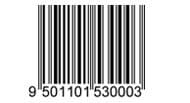
EAN barcodes have much in common with UPC codes, with the key difference being they are widely used in Europe rather than America. They are also found on a wide variety of consumer goods. Standard EAN codes are 13 digits, while the shorter version has eight numbers.
-
Code 39
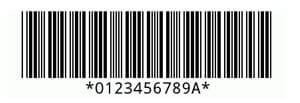
Code 39 barcodes can include numbers, letters and symbols and are primarily used by the U.S. Department of Defense and in certain manufacturing sectors, like automotive production.
-
Code 128
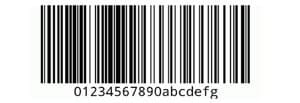
This is a more advanced version of Code 39, and got its name because Code 128 can include any of the 128 characters in ASCII. The ability to choose from a larger number of characters expands the amount and type of data that can be encoded. Code 128 is often used in B2B purchasing, distribution and transportation.
-
Codabar (NW-7)
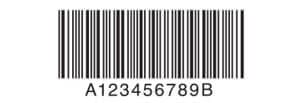
One of the earlier barcode formats, Codabar codes may include any number and the letters A-D. While no longer a leading type of barcode, certain libraries, blood banks and delivery services still use it.
-
Interleaved 2 of 5
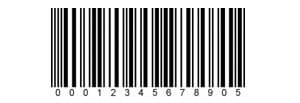
Interleaved 2 of 5 barcodes use only numbers and contain a high density of bars. The total number of digits must be even, so businesses will sometimes add a zero at the beginning. This type of code is common in warehousing and shipping, and also appears on some employer-issued badges.
-
QR code

Most people have used QR codes, or are at least familiar with them. Newer versions of smartphones can read these barcodes with their built-in cameras. Toyota invented QR codes in 1994, and today they can be used to direct consumers to a website, confirm a person’s identity on a login page or encrypt data. A QR code can encode more than 7,000 numbers or 4,000 letters.
-
PDF417
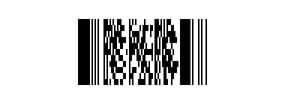
This is a 2D barcode that uses stacked linear rows and consists of anywhere from three to 90 rows. Each row is comparable to a basic linear barcode. You can find PDF417 barcodes on driver’s licenses and other ID cards, as well as in warehouses.
-
Data matrix

One other popular type of 2D barcode is data matrix. This barcode can store not just alphanumeric characters, but files. Data matrix barcodes have robust error-checking capabilities, which allows scanners to still read these codes even when they have significant damage. Since the barcode can stand up to tough conditions, it’s often used on surgical tools, circuit boards or electrical rating plates on appliances.
5 Ways to Use Barcodes
There are countless use cases for barcodes, and they can dramatically increase the efficiency and accuracy of your daily operations. Here are a few of their most popular uses:
-
Tracking inventory: Companies need to know not just their current inventory levels, but the location of those products, at all times. Barcodes can resolve that warehouse management issue—warehouse associates scan new items as they arrive and again when they’re shipped out as part of an order; in more automated facilities, mounted scanners might scan products as they move along a conveyor. Every SKU needs a barcode, of course, and codes must be linked to a database that has all the necessary product information. But once that’s set up, inventory numbers will always be reliable and update in real time.
-
Tracking assets: Barcodes are the most popular method for tracking the assets that businesses use to support their daily operations, like machinery, cars and computers. Barcodes, paired with asset tracking software, help businesses monitor the status and location of those assets and store any relevant records about maintenance or repair. This is important because, unlike inventory, organizations often hold onto capital assets for years and use them repetitively. For mobile items like computers or vehicles, barcodes can show who last used those items and when. They also help company leaders understand the usage and condition of different assets as they plan future investments.
-
Invoicing: Many organizations put barcodes on invoices to make it easier to track accounts payable (AP) and accounts receivable (AR). Companies could put barcodes on invoices to tie it to a specific customer. When the customer pays, an employee can scan the barcode to make sure they credit the correct account, and could follow the same process for AP debits. Invoice barcodes can also expedite the fulfillment process. A warehouse worker could print the invoice for an order, then scan the code to figure out which items to pick and where they’re located, reducing the chance for mistakes. Or the worker could scan the barcode after gathering all the items for an order to confirm the package contains all the correct items.
-
Mail: Much like with inventory, businesses can use barcodes to track all the mail and packages they send out. They can scan letters and packages before handing them off to couriers to link tracking information to that order, and then send it to customers so they can check the status of their orders. If mail is returned to the seller, it can scan the barcode to quickly identify the customer it needs to contact to resolve the issue.
-
Mail Merges: A mail merge links a data source, like a spreadsheet, with another document to automatically plug that data into preset fields. Business can use mail merges to create barcodes for a batch of items in a few simple steps. It’s a much more efficient method than handling them one by one.
How to Create Barcodes
Companies that need a small number of barcodes may use a mail merge or a free online tool to generate their barcodes and then print them out with a standard printer. However, this can quickly become inefficient as your needs grow.
A more efficient option is to use your accounting or inventory software to create barcodes—even basic systems generally have this capability and will make it simple to link each barcode to specific item records in your product database. For most businesses, it will make sense to pair this technology with a barcode printer that’s specifically designed to print labels and can cost as little as a few hundred dollars.
However, businesses that need barcodes for external use—for example, to track items sold through a third-party retailer—need to register through GS1. The organization charges an initial fee as well as an annual renewal fee, and pricing varies depending on how many barcodes you need. GS1 will give your company a unique ID, known as a GS1 Company Prefix, which will be part of all your barcodes. This membership also gives you access to the GS1 Data Hub, where you can create and manage your barcodes and export those files to a printer.
GS1 is an international organization and supports UPC and EAN barcodes, as well as different 2D codes.
How Barcodes Help Business
Few technologies have gained such widespread adoption over the last half century as barcodes, and for good reason. They are a simple, effective and extremely reliable way to track inventory, which represents a large chunk of potential revenue and expenses for many companies.
New businesses or those that don’t yet use barcodes should figure out what type of barcodes best meet their needs and be sure to use and scan them consistently. It’s a small investment that provides a rapid return on investment through improved inventory control and accuracy and access to real-time data. Barcodes play a central role in giving companies the visibility they need to control costs and provide an excellent customer experience.
Barcode Technology
Businesses need just a few pieces of technology to start using barcodes. There are three key components:
- Printer: As noted earlier, you will want a printer designed for barcodes if you have even a few hundred items in your warehouse or replace products regularly. There are a wide range of printers available—some are large and need to be plugged in, while others are wireless and built to be portable. Depending on the size of your operation, you may need multiple printers for different areas of the warehouse or store.
- Scanner: Scanners enable organizations to take advantage of the many benefits barcodes provide. There are a few different types of scanners to choose from: Laser scanners are the most popular because they’re relatively inexpensive, can read codes from up to two feet away and can read most 1D barcodes. Charge-coupled-device (CCD) scanners, which use hundreds of LED lights to read barcodes, are more accurate than laser scanners but have a shorter range. If your company uses 2D barcodes, you’ll need an imager scanner that uses a camera to capture those more-advanced barcodes.
- Central database: Barcodes are useful only if a computer can link those unique identifiers to a certain product. So a company needs a central data source that ties each barcode to a specific product to ensure scanning a barcode renders the right information. This data is often stored within a software application that point-of-sale (POS) systems and warehouse devices can access.
How Inventory Management Software Can Help
Inventory management software is critical to capitalizing on all the advantages that come with barcodes. This system is a logical place to store all product information, including barcodes, and can serve as the database that feeds information to the computer when someone scans a barcode.
With both barcodes and an inventory management system in place, a company always has a complete and accurate picture of current inventory levels and related metrics. Each time a product is put on or pulled from a shelf, an employee simply scans it, and that scan automatically updates data in the inventory management system. This prevents situations where the organization unexpectedly runs out of stock and misses out on sales for weeks while waiting for a replenishment order to arrive. The solution can also record the location of each SKU, leading to faster fulfillment times and lower labor costs.
By using barcodes to update supply chain management software in real time, business leaders always have accurate and current information as they place new purchase orders, choose which items to promote and figure out how to offload slow-moving inventory.
And better purchasing decisions put companies in a position to surpass the competition and grow.











